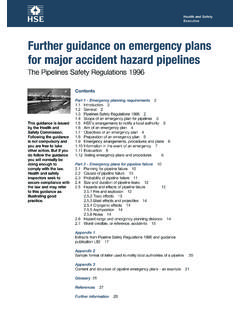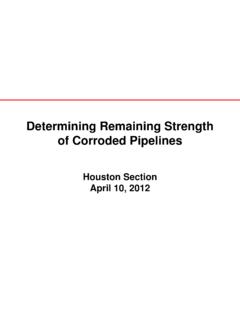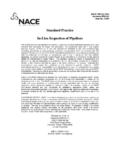Transcription of GUIDELINES FOR PIPELINE OPERATORS ON PIPELINE …
1 GUIDELINES FOR PIPELINE OPERATORS ON PIPELINE anchor hazards GUIDELINES FOR PIPELINE OPERATORS ON PIPELINE anchor hazards FOREWORD This document is intended to help PIPELINE OPERATORS and other relevant stakeholders by setting out good practice guidance on the design, management and protection of pipelines from anchor hazards . Recent incidents have shown that the threat to PIPELINE integrity from anchor damage can be significant and it is important that PIPELINE OPERATORS adequately address anchor hazards in design & within Major Accident Prevention Documents (MAPD) and where appropriate, provide suitable protection and/or controls to manage the risk.
2 This guidance is primarily focused towards near-shore major trunk pipelines in the vicinity of Port/Harbour areas, where there is likely to be significant marine/vessel traffic and/or anchoring zones. However, it may also be relevant to both in-shore areas ( pipelines crossing major estuaries and rivers) and anchor handling operations in the vicinity of UKCS Installations and associated pipelines. This document was written and compiled under the direction of a Working Group established to address the final recommendation from the Marine Accident Investigation Branch (MAIB) Report into the Young Lady anchor incident near Teesport in June 2007.
3 The incident involved anchor damage to the BP Central Area Transmission System (CATS) Gas PIPELINE and resulted in the PIPELINE being shutdown for a number of months before repairs could be completed. The working group which comprised of representatives from the Department of Transport (DfT), Department of Climate Change (DECC), Maritime Coastguard Agency (MCA) and the Health & Safety Executive (HSE) was tasked to conduct a review of the risk assessment process for the protection of pipelines from surface vessel interaction. One of the key findings of the group was that there appeared to be relatively limited coverage of anchor hazards within UK Codes/Standards and other publicly available guidance, with the information spread across a number of different sources.
4 Development of this guidance naturally followed with the key aim to update and pull together all the relevant information and material into a single reference document. The main body of the document begins with a brief summary on the limitations of existing guidance before presenting an assessment overview of current anchor related incidents from PARLOC 2001. It then addresses the risk assessment requirements for compliance with the PIPELINE Safety Regulations and associated Major Accident Prevention Document (MAPD) and provides guidance in relation to failure frequency calculations and consequence assessment.
5 The guidance then highlights key areas that need to be addressed within PIPELINE emergency procedures when dealing with anchor damage incidents. In particular it focuses on PIPELINE damage and repair strategies and any required PIPELINE isolation and depressurisation arrangements. It concludes with an overview of the main protective measures and controls currently available to protect against anchor hazards . References to relevant published information and studies are provided throughout the document. The Appendices provide more detailed information in relation to the PARLOC anchor incident data and analyses.
6 They also give information on the range and types of modern anchors, giving detailed description of their key features and dimensions. Appendix 3 provides a table of the main physical protection measures along with a brief review of the reasonable practicability and effectiveness of their use to protect against anchor hazards . This Guidance can be equally used to assist with both the design of new pipelines and in any review of the arrangements for anchor hazard protection of existing operational lines. Related guidance for Harbour/Port Authorities has also been established, following the CATS incident.
7 It forms part of the Guide to Good Practice on Port Marine Operations which has Page 1 of 14 30/12/2009 GUIDELINES FOR PIPELINE OPERATORS ON PIPELINE anchor hazards Page 2 of 14 30/12/2009 been prepared in conjunction with the Port Marine Safety Code. The new Port Marine Safety Code (PMSC) and accompanying Guide to Good Practice were officially launched at the end of October 2009 by the Shipping Minister and representatives from industry on HQS Wellington.
8 The latest versions of both documents can be found on the DfT website. A harbour authority needs to be aware of the presence of any subsea pipelines in its area of responsibility. It should recognise and assess the potential for damage to those pipelines from shipping and fishing operations, and the associated potential consequences of such damage as part of its navigational Safety Management System. This PIPELINE operator Guideline may be reviewed from time to time and it would be of considerable assistance for any future revision if users would send comments or suggestions for improvements to: Health & Safety Executive, HID SI 3 Gas & Pipelines Unit, Lord Cullen House, Fraser Place, Aberdeen AB25 3 UB Tel: 01224 252500 Email.
9 FOR PIPELINE OPERATORS ON PIPELINE anchor hazards Guidance for PIPELINE OPERATORS on appropriate measures to protect against anchor damage Background Following a series of anchor damage incidents to offshore subsea pipelines including the Young Lady incidenti with the BP CATS PIPELINE in 2007, the regulatory authorities (HSE, DfT, MCA and DECC) identified the need to give guidance on appropriate measures to protect new pipelines and where necessary, provide retrospective protection to existing pipelines. t afety Regulations 1996, PIPELINE OPERATORS can help ensure that such a threat is minimised.
10 Or several weeks causing disruption to upplies downstream and large financial implications. for s to many hundreds of thousands of domestic, commercial and industrial onsumers. or undertake risk assessment and specify appropriate easures against anchor damage. ry but f vessels in the vicinity of UKCS installations and ipelines and their subsea equipment. the Statoil Kviteb rn 30 gas ipeline (Norwegian sector) are not included in this data. for the same period. There are around 50 hydrocarbon pipelines making landfall in the K. anchor hazards can pose a significant threat to PIPELINE integrity.














